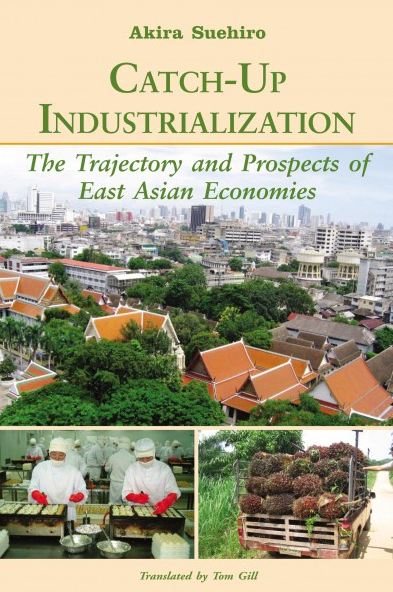Akira Suehiro, Catch-Up Industrialization: The Trajectory and Prospects of East Asian Economies
Translated by Tom Gill. Singapore and Kyoto: NUS Press and Kyoto University Press, 2008. Pp. xvi, 395; tables, figures, note on names, notes, bibliography, author and subject indices.
Review by Rick Doner.
Akira Suehiro is a pioneer of the study of modern Southeast Asian political economy. Along with scholars such as Richard Robison, Kevin Hewison and Gary Rodan, Suehiro has distinguished himself by taking Southeast Asian capital seriously. Through relentless data gathering and sensitivity to historical context, he has not only documented the growth of diversified business groups in Thailand but also in an extensive set of studies, such as Capital Accumulation in Thailand 1885-1995 (1), shed light on the shifting political contexts in which this development occurred. This work has had an important theoretical impact: it provided the basis for other scholars to break out of a narrow dependency-theory framework that assumed that local capitalists in developing countries functioned solely as subordinate representatives of multinational corporations. Instead, Suehiro has argued, Thai capital and its constituent parts, especially banks and diversified business groups, function as key components of a late industrializing economy. His subsequent work has ranged from more straightforward political economy, as in his 2010 study of industrial restructuring policies in Thailand (2), to broader, more comparative work on the institutions of late developers, as represented in the volume under review, Catch-Up Industrialization, translated from Japanese into a very readable English-language version by Tom Gill.
This impressive study is divided into two parts. The first, containing four chapters, presents the broader concepts and theories framing the book’s empirical analysis. One of the most useful features of this part of the book is Suehiro’s comprehensive, critical and readable overview of approaches to late development, ranging from Liszt and Gerschenkron, to cultural/Confucian approaches, to Akamatsu’s “flying geese” model, to Michael Porter’s national competitiveness framework, to Schumpeter’s approach to innovation, to the “Washington Consensus” and its statist critics, such as Alice Amsden. Along with the treatment of these approaches are discussions of Japanese scholarship that may be less known to Western readers.
This overview leads to the presentation of the book’s core organizing concept, what Suehiro calls “social capability” for industrialization (page 8), a concept that highlights the roles and interactions of important public and private agents in national development and bears resemblance to formulations such as “systems of innovation.”(3) The concept not only helps to shed light on the Asian Financial Crisis, discussed in Chapter Four. But, most critically, it also structures Suehiro’s ability to do in the nine chapters comprising the second part of the book what few analysts even attempt – namely, to explore development from bottom to top: from the factory floor and labor markets, to systems of education and training, to strategies of multinationals and domestic family-owned groups, to global value chains, to the ideologies and politics of developmentalism.
A book with the breadth and depth of this study defies easy summary, but several specific strengths merit special note. First, Catch-Up Industrialization does more to integrate diverse theories, such as human capital theory and Schumpterian approaches to innovation, with a wide range of empirical evidence more than almost any book I can think of. Second, book is more comparative than most. Suehiro seeks to account for variation in development in East Asia by combining in-depth analysis of Thailand, the country to which he has devoted much of his career, with theoretically and empirically informed analysis of other national experiences, including Japan’s. Third, Suehiro’s treatment of a central concern of the book – innovation –avoids one-size-fits-all approaches to the topic. It recognizes diverse challenges of different stages, and emphasizes the incremental nature of technology absorption and innovation in late developers. Fourth, the book stresses that success in efforts toward innovation requires systemic coordination among key actors and functions. One factor that distinguishes Thailand from its higher-performing counterparts among the East Asian newly industrialized countries (NICs) relates to the importance of integrating trade policy with industrial policy. Fifth, however, what this book offers is far from a state-centric argument. Suehiro avoids glorifying the state by recognizing both costs and benefits of state initiatives, by tracing the shift from states as conductors to facilitators, and by stressing the crucial roles of local firms and labor.
Another strength is that the book’s analysis of import substitution and export promotion strategies highlights the importance of linkages, including in the case of agriculture. Suehrio is especially thoughtful on Thailand’s agricultural diversification and the resultant linkages, as these contrast with the trajectories of the East Asian NICs. His even-handed treatment recognizes the country’s significant achievements as a newly agro-industrializing country (NAIC). But it also notes the risks in such a strategy. These include not only environmental problems but also, and most critically for Suehiro’s analysis of Thailand’s weaknesses, the fact that an agriculture-based industrialization strategy is in some ways self-limiting. Because it “does not require a high level of domestic technology formation,” the strategy more easily attracts capable rivals and “does not upgrade a country’s industrial structure” (pages 138-139).
Of course, labor–as class and human capital–is fundamental to innovation, and Catch-Up Industrialization devotes significant space to the structure of labor markets, to personnel management, to the politics of labor movements, and to diverse approaches to education and training. These pages document important shifts in East Asian workforces, including not only growing female participation but also a pattern that has only increased in significance since the book’s publication – namely, the expansion of casualization, usually in the form of short-term contract workers. Suehiro’s discussion of human resource development recognizes plain old exploitation, but he usefully emphasizes the factory floor frictions that arise from rapid shifts to new labor systems as part of the move to export promotion (page 278). The book’s discussion of labor politics highlights the fact that worker participation in post-war Japan and the NICs occurred “more in the context of shop-floor management than in politics, notably through collective contributions to movements to improve productivity and quality control” (page 281), that such productivity-related engagement has not occurred in Thailand, and that the 1997 Asian Financial Crisis provoked a move to ever-more flexible labor markets and weakened labor representation across the region, especially in Thailand. Only in Singapore, Suehiro notes, does labor, through the National Trades Union Congress, seem to constitute a partner in productivity growth, albeit a politically subordinate one.
Not surprising, this book’s broad scope and ambitions result in some tensions and gaps. An important substantive tension involves the question of Thai capital. Even as Suehiro highlights the potential of family-owned business groups as indispensable components of Thailand’s catch-up process, he recognizes the weaknesses in these firms’ “organizational capability” (page 245) to absorb and develop technology. One is left with the question, what happened to Thai capital? Here the analysis could have benefited from a more explicit and systematic political economy treatment of the negative complementarities between political dynamics, such as coalitional instability and populism, and corporate strategies that stress risk reduction, through diversification rather than the development of technological competence.(4) A more extensive political analysis could also have helped account for the ever-deteriorating position of labor both as political force and as partner in productivity growth. Here it would have been useful to draw out the impact of the growing casualization and informality noted briefly in the book. Addressing both of these issues would have allowed Suehiro perhaps to anticipate the dangers of the middle-income trap.
But a book can’t do everything, and this one does much more than most not only to address the core challenges facing late developers, but also, in its concluding chapter, to address goals such as job creation, income distribution, and broader quality of life. Such goals have become ever more challenging for countries such as Thailand, as they attempt to reconcile engagement in today’s global economy with sustainable and inclusive development.
Rick Doner is Goodrich C. White Professor of Political Science at Emory University.
References
1. Akira Suehiro, Capital Accumulation in Thailand 1885-1995 (Tokyo: Center for East Asian Cultural Studies, 1989).
2. Akira Suehiro, “Industrial Restructuring Policies in Thailand: Japanese or American Approach”, pp. 129-173 in Patarapong Intarakumnerd and Yveline Lecler, Sustainability of Thailand’s Competitiveness: The Policy Challenges (Singapore: ISEAS, 2010).
3. Richard Nelson, National Innovation Systems: A Comparative Analysis (New York: Oxford University Press, 1993).
4. Ben Schneider, Hierarchical Capitalism in Latin America: Business, Labor, and the Challenges of Equitable Development (New York: Cambridge University Press, 2013).
 Facebook
Facebook  Twitter
Twitter  Soundcloud
Soundcloud  Youtube
Youtube  Rss
Rss 
